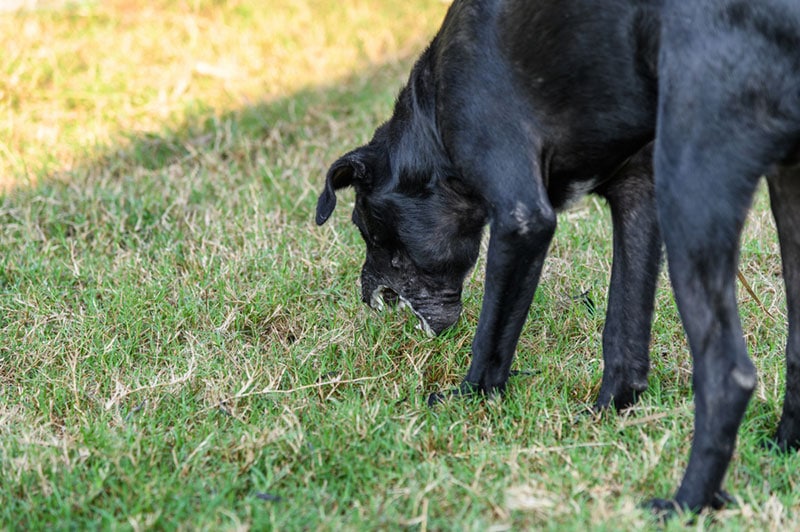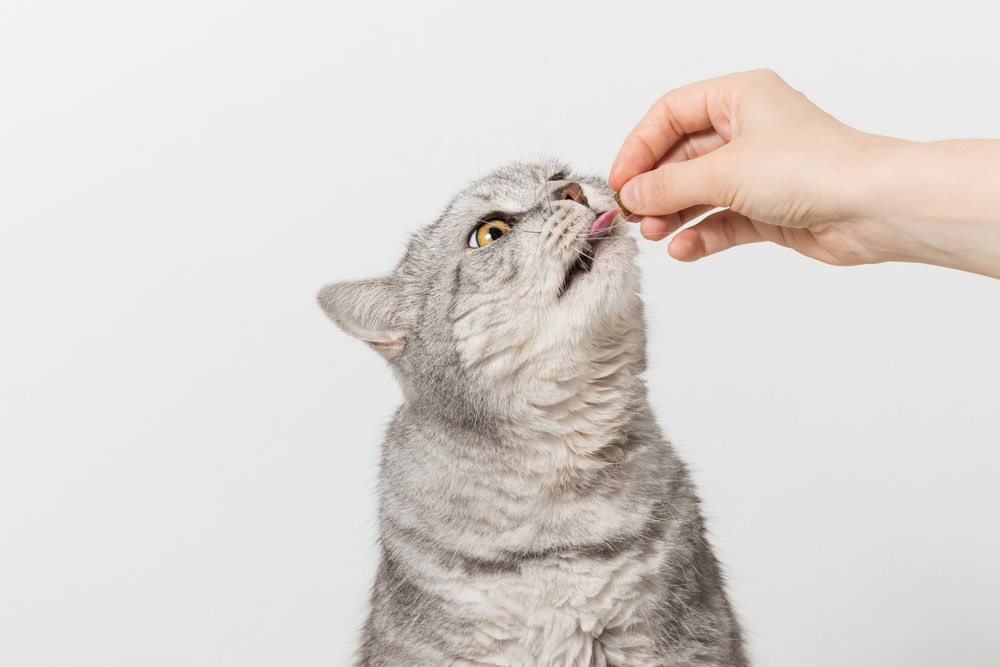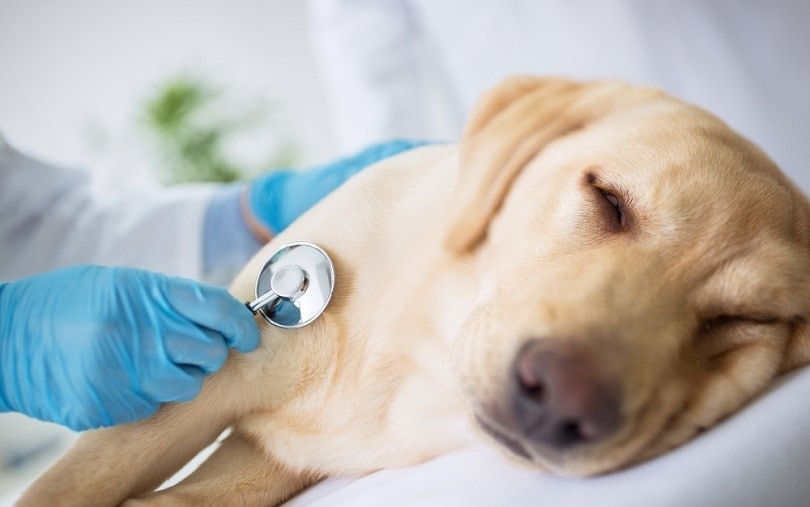My Dog Ate Toy Stuffing: Here’s What to Do (Vet Answer)

Updated on

Click to Skip Ahead
When a dog eats something they are not supposed to, fear of the potential unknown can cause understandable panic to a concerned pet owner. One commonly consumed item that may cause anxiety to the pet owner when ingested by their dog is the toy stuffing from stuffed animal toys. Is this really a hazard? Can dogs digest it on their own? What should you do if this happens?
If your dog ends up consuming toy stuffing, this article discusses what to do next as this could be a potentially dangerous situation depending on several factors. In addition, we’ll also discuss potential complications and preventative tips.
What to Do:
- Work quickly and calmly—a faster response is more likely to produce a better outcome.
- Remove any other stuffed material from being consumed and set aside in a safe place that your dog cannot access.
- Try to piece together the situation. Roughly how long ago did this happen? What exactly was eaten versus strewn around the area? If toy stuffing was consumed, can you piece together roughly how much? If a squeaker or another part from the toy was consumed, how big were the pieces that were ingested? Try to figure out these details because they are important for the next step.
- Contact your local veterinary practice or if they are unavailable, an emergency veterinary practice. Be sure to explain what and how much they likely ingested, the suspected timing of when this occurred, and your dog’s size.
- Follow your veterinarian’s advice. The dog’s size as well as when, what, and how much was consumed will be some of the pertinent contributing factors that they will consider heavily. Do not induce vomiting at home without the consultation of a veterinarian as this could itself be a hazard.
Potential Concerns
You might be wondering, what’s the big deal with toy stuffing? As this item is not digestible for dogs, it has the potential to cause a range of problems. The good news is if it’s a small amount of stuffing in relation to the dog’s size, it is likely to pass uneventfully. The problem is that in each situation, the results could range from no known problems to an upset stomach, choking, or diarrhea, with the worst-case outcome being a foreign body obstruction.
A foreign body obstruction is when a dog eats an item, and it gets stuck in the digestive tract and can block the normal passage of digestive material. It may form a full or partial blockage and common areas where this occurs include in the stomach or small intestines.
Whether a foreign body obstruction occurs with toy stuffing will be a matter of the size of your dog, the amount of stuffing they consumed, and an element of luck. Because of the specifics of each case, the recommended course of treatment may vary. In addition, there is often a cost-versus-risk-based assessment and there may be pros and cons with each course of treatment that your veterinarian can discuss with you.
Some possible options might include waiting and observing for signs of illness, if within a certain time frame inducing vomiting right away, radiograph and wait/observe, surgery, etc.

Foreign Body Obstruction Signs
As mentioned, the largest worry with eating toy stuffing is a foreign body obstruction. While this will not occur in every case, it is largely determined based on the size of the dog in question, as well as the amount of stuffing consumed. For example, if a Chihuahua ate most of the stuffing from a large stuffed animal that’s bigger than them, there is more likely to be a problem than if a Bull Mastiff ate a couple of wisps of toy stuffing.
- Continual, repeated vomiting
- Lethargy
- Not wanting to eat and/or drink
- Straining to defecate
- No bowel movements
- Diarrhea; blood in the stool
- Bloating of the abdominal area
- Painful abdomen
My Dog Has an Obstruction, Now What?
If an obstruction is suspected or present, common lab work that may be needed could include bloodwork, radiographs, a barium study (giving a specialized product orally to act as a contrast in the digestive tract with subsequent X-rays monitoring over time), and/or an ultrasound.
If confirmed or strongly suspected, a surgery that explores the abdominal digestive tract area (called an exploratory laparotomy or celiotomy) with the hope of retrieving the obstruction in question would be the next step. In some cases, endoscopy may be an option for retrieval of specific objects, but in the case of toy stuffing, this may not be as helpful.
Regardless of the procedure needed to remove a foreign obstruction, time is of the essence as an obstruction can cause areas of the digestive tract to die. The longer the obstruction goes on, the more it can become a bigger issue, with portions of the digestive tract dying that will then need to be removed, a pet going into shock, or even death.

Recommendations for Prevention
The popular expression, “an ounce of prevention is worth a pound of cure” is a great reminder that it can be less work to try to keep something from happening than have to deal with the aftereffects. With this thought, here are some recommended tips to help prevent a foreign body obstruction in your dog due to a dog toy such as that with toy stuffing.
- Use dog-approved toys, treats, and chews only under supervision.
- Ensure your dog’s toys are made for their size so as not to be too large for them or a choking hazard.
- Determine your dog’s chewing style. Some dogs are tough chewers and there are more durable toys marketed specifically for these types of pooches.
- Regularly inspect your dog’s toys. Once one has been damaged or has quite a bit of wear-and-tear, such as with stuffing exposed, remove it right away.
- For dogs that just want to continually pull out and eat stuffing from any stuffed toy, alternatives could include food or treat puzzles, kong and rubber-like toys, etc.
- Prevent access to rooms or areas where stuffed toys may be freely available such as a child’s room, playroom, etc.
- Work on commands such as “leave it” so you can remove a worrisome item promptly from your dog if the situation arises.
- For dogs that chronically eat things that could be dangerous such as toy stuffing, training them to comfortably use a basket muzzle may help them not be able to access the toys or items in question while still allowing them to drink, pant, etc.
Conclusion
Toy stuffing is not a digestible item, and if consumed by a dog, can result in a potential health hazard. This will depend on the size of the dog and the amount of material ingested. Ultimately, if toy stuffing is consumed, there could be a variety of results ranging from the dog passing the stuffing in the stool uneventfully all the way up to a foreign body blockage that could result in death.
Because of this risk, prevention is key, and in the event of consumption, contacting your dog’s veterinarian for further advice is the next best step.
Featured Image Credit: enchanted_fairy, Shutterstock












